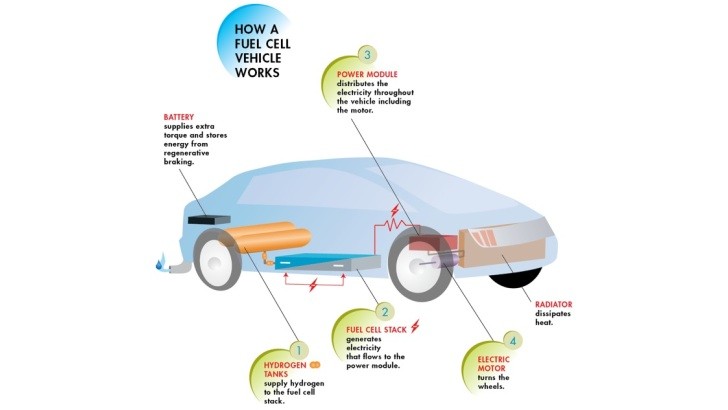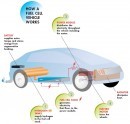A lot of fuss has been recently created around fuel cell vehicles, which are advertised as the cars of the future and will hit mass production next year. Since we heard a lot of questions lately from misinformed people, we decided to settle it here once and for all.
So, without further ado, we’ll try to respond here to the most common questions regarding fuel cell vehicles. If we haven’t covered everything here, just shoot your question in the comments.
Hydrogen, which is stored in a tank onboard the vehicle, is run through the fuel cell stacks and combined with the oxygen in the air, which as opposed to electrolysis, creates water and electricity.
Each fuel-cell is made out of an anode (through which the hydrogen is pumped), a catalyst (that facilitates the reaction) and the cathode (through which oxygen travels).
One single cell is not enough to power the car, so automakers are stacking more of them together in something that looks like a battery. In fact, it can be regarded to as a battery that makes its own electricity.
Currently, most of the hydrogen used in the industry is obtained from natural gas, some is made through water electrolysis and another part is obtained from bio-methane.
A lot of energy has been spent so far to extract the oil and process it to be burned by engines and this works pretty well. It could work endlessly if the oil could last infinitely or pollution wouldn’t occur.
Same goes for hydrogen obtaining too. A plan to use wind-power or solar cells in hydrogen-obtaining plants is undergoing, which will cut the expenses on long term.
More than that, a gallon of gasoline costs $3.5 and you can go 50 miles on an average with it. One kg of hydrogen costs around $5, but upcoming fuel cell vehicles will do 70 miles per kilogram of hydrogen.
range - the best EV now (2014 Tesla Model S) can go for around 200 miles, while Toyota’s FCV is estimated to go at least 300 miles on a full charge.
recharging times - the same tesla needs an hour on a special high-capacity recharging station to top up its battery level, while the FCV only needs around 3 minutes to refill the hydrogen tanks.
So, until those new battery concepts come to reality, hydrogen seems the best alternative.
Toyota just did it’s homework and says it will release the affordable mass production fuel cell vehicle next year, as its further research cut the costs from over $100,000 to $70,000.
But then, so did Honda and Hyundai said to do next year. Which one will be the best? We’ll just have to wait and see.
With help from the government, automakers are expecting to sell enough fuel cell cars to get the business moving and lower the production costs even more.
Remember how expensive the first cellphones were about 20 years ago? Well, now you can get one for $60 and that’s how it works with every new technology that comes by. So yeah, if people buy fuel cell, production costs will decrease.
The hydrogen in your car will be contained by tanks guaranteed at 700 atmospheres. Toyota shot their tank with different bullets and only a 50 cal penetrated it. And even so, they said the hydrogen just escaped with a big “whoooshhh”.
Other than that, what can we say; filling up your hydrogen tank will be similar to filling the LPG (liquified petroleum gas) one. Pull up at the pump, attach the hydrogen nozzle to the tank’s refilling system, fill it up, disconnect it and pay for the fuel. Don’t forget to buy an air freshener...
Are fuel cell cars actually burning hydrogen?
This is the biggest misconception of them all. NO, fuel cells are using hydrogen to create electricity that powers the car’s wheels via an electric motor.How does hydrogen gets to create electricity, then?
Remember that chemistry class where they showed you that running an electric current through water (electrolysis) turns it into hydrogen and oxygen? Good, because a fuel cell does exactly the reverse process.Hydrogen, which is stored in a tank onboard the vehicle, is run through the fuel cell stacks and combined with the oxygen in the air, which as opposed to electrolysis, creates water and electricity.
Each fuel-cell is made out of an anode (through which the hydrogen is pumped), a catalyst (that facilitates the reaction) and the cathode (through which oxygen travels).
One single cell is not enough to power the car, so automakers are stacking more of them together in something that looks like a battery. In fact, it can be regarded to as a battery that makes its own electricity.
Where does hydrogen come from?
Hydrogen is one of the most abundant elements on the planet. The only bad (and good at the same time for us to live) thing is that it’s found in combination with other elements in water, natural gases and other resources.Currently, most of the hydrogen used in the industry is obtained from natural gas, some is made through water electrolysis and another part is obtained from bio-methane.
So if you have to invest energy to obtain pure hydrogen, how is this feasible?
Well, here’s the tricky part. As with the gasoline, hydrogen is basically an energy carrier. Through burning, gasoline creates heat and pressure, which are used to power the wheels, while the hydrogen getting combined with oxygen creates electricity used in an electric motor to move the car.A lot of energy has been spent so far to extract the oil and process it to be burned by engines and this works pretty well. It could work endlessly if the oil could last infinitely or pollution wouldn’t occur.
Same goes for hydrogen obtaining too. A plan to use wind-power or solar cells in hydrogen-obtaining plants is undergoing, which will cut the expenses on long term.
More than that, a gallon of gasoline costs $3.5 and you can go 50 miles on an average with it. One kg of hydrogen costs around $5, but upcoming fuel cell vehicles will do 70 miles per kilogram of hydrogen.
But if we rely on the wind and sun to make electricity that separates hydrogen from other stuff, why can’t we just use the electricity itself to power electric vehicles?
You are half-right here. Yes, EVs come at the advantage of price and simple operation, needing only to be plugged in to the grid to get recharged, but the have two huge limitations:range - the best EV now (2014 Tesla Model S) can go for around 200 miles, while Toyota’s FCV is estimated to go at least 300 miles on a full charge.
recharging times - the same tesla needs an hour on a special high-capacity recharging station to top up its battery level, while the FCV only needs around 3 minutes to refill the hydrogen tanks.
So, until those new battery concepts come to reality, hydrogen seems the best alternative.
Is Toyota the only automaker to sell fuel cell cars?
No, in fact it wasn’t even the first to create the first fuel cell car as many other producers have explored the alternative way in the past. However, due to high production costs, those prototypes and small batches of test cars never had too much success.Toyota just did it’s homework and says it will release the affordable mass production fuel cell vehicle next year, as its further research cut the costs from over $100,000 to $70,000.
But then, so did Honda and Hyundai said to do next year. Which one will be the best? We’ll just have to wait and see.
70 grand is still expensive for me, are the prices going to decrease at some point?
If you live in a country like Japan, who offers huge incentives for fuel cell vehicles, you can get one for $50,000.With help from the government, automakers are expecting to sell enough fuel cell cars to get the business moving and lower the production costs even more.
Remember how expensive the first cellphones were about 20 years ago? Well, now you can get one for $60 and that’s how it works with every new technology that comes by. So yeah, if people buy fuel cell, production costs will decrease.
Ok, it seem legit so far, but aren’t they dangerous? Driving around with hydrogen doesn’t seem a good idea and then there’s the Hindenburg that...
Oh come on, stop it with the Hindenburg. That happened 80 years ago and it was basically a huge ball of flammable materials containing a lot of hydrogen inside. It was waiting for a tear and a spark to go boom.The hydrogen in your car will be contained by tanks guaranteed at 700 atmospheres. Toyota shot their tank with different bullets and only a 50 cal penetrated it. And even so, they said the hydrogen just escaped with a big “whoooshhh”.
Mkay, but what about refueling stations?
Yeah, you got us here. Hydrogen refueling stations are indeed more costly to create than standard petroleum ones, but automakers that will sell fuel cells said they will financially help with the construction of these units.Other than that, what can we say; filling up your hydrogen tank will be similar to filling the LPG (liquified petroleum gas) one. Pull up at the pump, attach the hydrogen nozzle to the tank’s refilling system, fill it up, disconnect it and pay for the fuel. Don’t forget to buy an air freshener...

